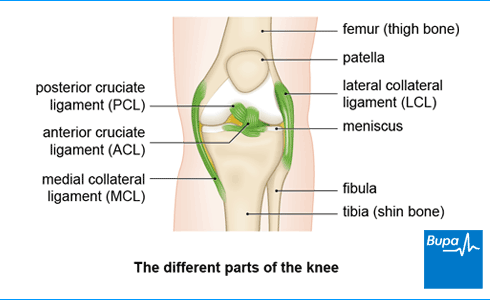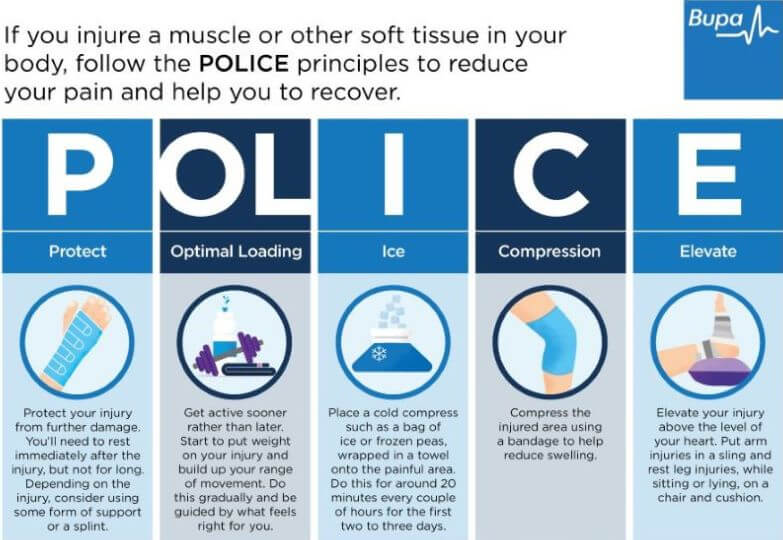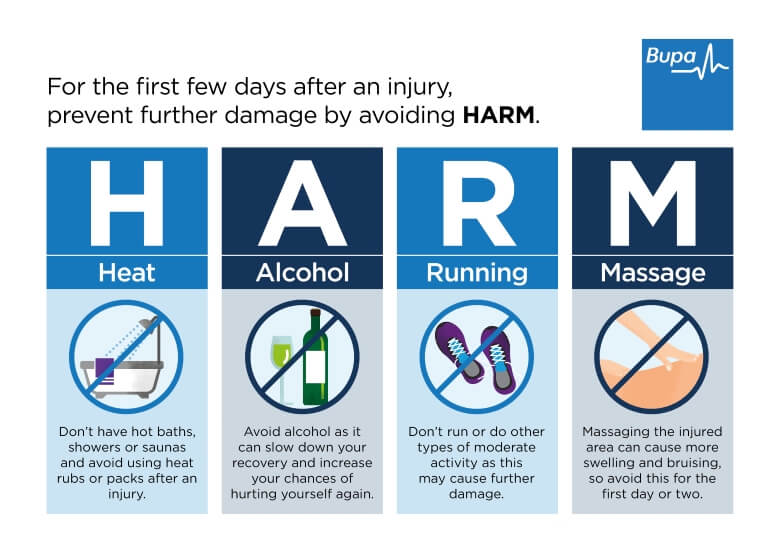Meniscus tear
Your health expert: Mr Damian McClelland, Trauma and Orthopaedic Consultant, and Clinical Director for Musculoskeletal Services at Bupa
Content editor review by Rachael Mayfield-Blake, Freelance Health Editor, June 2023
Next review due June 2026
A meniscus tear is an injury to a part of your knee called the meniscus and is a common knee injury. The menisci are two crescent-shaped pads of thick, rubbery shock-absorbing cartilage in your knee joint. They lie between your thigh bone (femur) and your shin bone (tibia).

About meniscus tears
You have one meniscus on each side of your knee – the medial meniscus on the inside and the lateral meniscus on the outside. Your menisci act like shock absorbers, absorbing the impact of your upper leg on your lower leg. They also help to stabilise your knee joint and keep the movements of your knee smooth.
Meniscus tears often happen when you play sports, but you can also get them as a result of wear and tear as you get older. When people talk about ‘torn cartilage’ in their knee, they usually mean a meniscus injury. These injuries are given different names depending on how they look, and where the tear is in the meniscus.
It’s possible to damage other parts of your knee as well as your meniscus. For instance, you might sprain or tear a ligament in your knee, such as your anterior cruciate ligament.
Causes of meniscus tears
In younger people, meniscus tears are usually caused by twisting your knee. This often happens when you play a sport, for instance football or basketball. In older people, the menisci can become worn down and tears can result from more minor injuries, such as twisting awkwardly when you stand up. These are called degenerative tears.
Symptoms of meniscus tears
You might still be able to walk on your injured knee or continue playing a sport after tearing your meniscus. But your knee will gradually get stiffer over the next day or so. Other meniscus tear symptoms include:
- feeling a ‘pop’ if you tear your meniscus
- pain in your knee, which can vary in severity – it might be mild or severe, and it may come and go
- swelling – this usually happens several hours after you injure your meniscus
- a feeling that your knee is catching or locking, usually when it’s bent – you may notice it clicking
- your knee feeling unstable and that it’s going to give way
- not being unable to bend and extend your knee fully
- your knee feeling tender along the line of the joint
Self-help for meniscus tears
It’s a good idea to follow the POLICE procedure if you injure your meniscus. POLICE stands for the following.
Protect. Protect your injury from further damage. Rest immediately after the injury but not for long. Consider using some form of support or crutches.
Optimal Loading. Get active sooner rather than later. Start to put weight on your knee and build up your range of movement. Do this gradually – be guided by what feels right for you.
Ice. Place a cold compress, such as a bag of ice or frozen peas wrapped in a towel, on your knee. Do this for around 20 minutes every couple of hours for the first two to three days.
Compression. Compress your knee using a bandage to help reduce swelling.
Elevation. Elevate your knee above the level of your heart to reduce swelling. Sit or lie on a chair and use a cushion to raise your leg.
There are certain things you should avoid in the first three days after your injury so you don’t damage your knee further. These can be remembered as HARM, which stands for the following.
Heat. Don’t have hot baths, showers, or saunas, and avoid heat packs and rubs.
Alcohol. Drinking alcohol can slow down your recovery and mask your symptoms – increasing the risk that you’ll injure yourself again.
Running. Don’t run or do any other form of moderate exercise.
Massage. Massaging the affected areas can cause more swelling and damage, so avoid this for the first day or two.
Both of these are measures you can take to treat any type of soft tissue injury to your knee, including a meniscus tear.
Treatment for meniscus tears
If you have symptoms of a meniscus tear, it probably won’t heal by itself and you’ll need some form of treatment. You’ll usually need to go to A&E with this kind of injury. They’ll examine you and take some X-rays or an MRI scan of your knee. You may then be referred to an acute knee clinic, which will organise any investigations and treatment you need.
What meniscus tear treatment you’re offered will depend on exactly where the meniscus tear is, how big it is, how severe your injury is, and your age. The initial treatment will be to control your pain and swelling using the POLICE and HARM self-help measures (see above). Further treatments for meniscus tears include physiotherapy, medicines and surgery.
You may see a physiotherapist or an orthopaedic surgeon (a doctor who specialises in bone surgery) for treatment.
Medicines for meniscus tears
You can take over-the-counter painkillers, such as paracetamol or ibuprofen, to help relieve any pain from a meniscus tear. As well as easing your pain, non-steroidal anti-inflammatory drugs (NSAIDs) such as ibuprofen may help to reduce inflammation and swelling. Your doctor may prescribe stronger painkillers if your pain is really bad.
Always read the patient information that comes with your medicine, and if you have questions, ask your pharmacist or GP for advice.
Physiotherapy for meniscus tears
Your physiotherapist will carefully assess your knee and plan an individual programme of rehabilitation exercises. These will be designed to help strengthen your knee and leg muscles gradually. This should help your knee recover its full range of movement as well as its strength and stability. Make sure you do the exercises because this is an important part of your recovery from a meniscus tear.
While recovering from a meniscus tear, try other activities to maintain your fitness. For example, you might try biking, walking on a treadmill, swimming, or other low-impact exercises. These shouldn’t cause any pain, so stop if they do.
Surgery for meniscus tears
If you have a large meniscus tear or you’ve tried other treatments and they haven’t helped, you may need an operation to repair your meniscus. Meniscus surgery might involve repairing your torn meniscus or removing the damaged part of your meniscus. Your surgeon will usually do the operation during a knee arthroscopy, which is a type of keyhole surgery.
You’ll need to have physiotherapy after surgery for at least 6 weeks to get your knee back to its normal function and working as it should.
Ask your doctor about the pros and cons of surgery and how it might help you.
Looking for physiotherapy?
You can access a range of treatments on a pay as you go basis, including physiotherapy.
To book or to make an enquiry, call us on 0370 218 6528∧
Signs of a meniscus tear in the knee include pain but it can vary – it might be mild or severe or come and go. You may feel that your knee is catching or locking. And your knee may feel unstable and that it’s going to give way.
For more information, see our section on symptoms of meniscus tears.
Whether a meniscus tear heals or not will depend on exactly where it is, how big it is, how severe your injury is and your age. While small tears may heal with self-help measures, you may need more treatment for larger tears.
For more information, see our section on treatment of meniscus tears.
Many people find they can still walk on their injured knee, but it might become stiffer over the next day or so.
For more information, see our section on symptoms of meniscus tears.
The best treatment for a meniscus tear will depend on exactly where it is, how big it is, how severe your injury is and your age. You’ll need to control any pain and swelling first using self-help measures. Further treatment for meniscus tears include physiotherapy, medicines and surgery.
For more information, see our sections on self-help for meniscus tears and treatment of meniscus tears.
Posterior cruciate ligament (PCL) injury
With a PCL injury, it’s common to injure other ligaments, or other parts of your knee, at the same time.
Anterior cruciate ligament (ACL) injury
An ACL injury can be a partial or a complete tear, an overstretch, or a detachment of the ligament.
Medial collateral ligament (MCL) injury
The MCL is the most commonly injured knee ligament. It often gets injured during sports such as rugby.
Lateral collateral ligament (LCL) injury
An LCL injury is often associated with injuries to the ligaments and tendons in this area, as well as to other parts of the knee.
Patellar tendinopathy (jumper's knee)
Patellar tendinopathy is also called ‘jumper’s knee’ because the injury commonly occurs during sports that involve jumping, such as basketball.
Patellofemoral pain syndrome
Patellofemoral pain syndrome is sometimes called ‘runner’s knee’ because it’s particularly common in people who run or do other sports.
Did our Meniscus tear information help you?
We’d love to hear what you think.∧ Our short survey takes just a few minutes to complete and helps us to keep improving our health information.
∧The health information on this page is intended for informational purposes only. We do not endorse any commercial products, or include Bupa's fees for treatments and/or services. For more information about prices visit: www.bupa.co.uk/health/payg
This information was published by Bupa's Health Content Team and is based on reputable sources of medical evidence. It has been reviewed by appropriate medical or clinical professionals and deemed accurate on the date of review. Photos are only for illustrative purposes and do not reflect every presentation of a condition.
Any information about a treatment or procedure is generic, and does not necessarily describe that treatment or procedure as delivered by Bupa or its associated providers.
The information contained on this page and in any third party websites referred to on this page is not intended nor implied to be a substitute for professional medical advice nor is it intended to be for medical diagnosis or treatment. Third party websites are not owned or controlled by Bupa and any individual may be able to access and post messages on them. Bupa is not responsible for the content or availability of these third party websites. We do not accept advertising on this page.
- Meniscal tear. BMJ Best Practice. bestpractice.bmj.com, last reviewed 23 April 2023
- Raj MA. Knee meniscal tears. StatPearls Publishing. www.statpearls.com, updated 18 July 2022
- Meniscus tears. American Academy of Orthopaedic Surgeons. orthoinfo.aaos.org, last reviewed March 2021
- Bezuglov E, Khaitin V, Shoshorina M, et al. Sport-specific rehabilitation, but not PRP injections, might reduce the re-injury rate of muscle injuries in professional soccer players: A retrospective cohort study. J Funct Morphol Kinesiol 2022; 7(4):72. doi: 10.3390/jfmk7040072
- Knee ligament injuries. Patient. patient.info, last edited 16 August 2022
- Knee pain – assessment. NICE Clinical Knowledge Summaries. cks.nice.org.uk, last revised August 2022
- Sprains and strains. NICE Clinical Knowledge Summaries. cks.nice.org.uk, last revised September 2020
- Non-steroidal anti-inflammatory drugs. NICE British National Formulary. bnf.nice.org.uk, last updated 27 April 2023
- Treatment for knee pain. Chartered Society of Physiotherapy. www.csp.org.uk, last reviewed 26 March 2020



